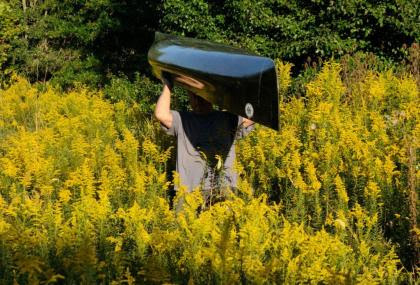Coloring Time
Article and photos by Joe Mish

The rise of Venus in the early morning eastern sky is the celestial harbinger of a pre-autumnal dawn. As if a conductor raising her baton to stir the first musical strands of an orchestral performance, Venus instead, transforms sound into symphony of color.
As the dark sky lightens, a fluorescent orange orb slowly struggles skyward appearing to have escaped from the earth’s fiery core.
Once free of the earth’s grasp, the sun’s blaze orange begins to fade, dissolving in the atmosphere, melting into a wild spectrum of ever-changing pastel tints. Tints that concentrate in intensity as they fall to earth and color the late summer greenery with splashes of vibrant golds, yellow and purple variants.
The summer green mantle, which covered open fields for the past three months, was worn as a uniform of sort to make differentiation among grassland vegetation a difficult task.
With the imperceptible fading hot breath of late summer, vast expanses of vibrant yellow appear, as goldenrod reveals itself as an actor would at the end of a play. Depending on the species, goldenrod’s display of brilliant yellow may vary even further with soil conditions. NJ.GOV/pinelands lists six species of goldenrod, a feast for late season migrating pollinators.
Splashes of vibrant purple fresh from dawn’s display of pastels, stand in brilliant contrast to appear as delicate embroidery in the expansive blanket of golden yellow and green. Purple loosestrife, an invasive non-native plant, has established itself along the river and moist, overgrown pasturelands. Though loosestrife blooms from June to September, its presence in late-summer, is for some reason, more spectacular, perhaps its vibrant color is now more intense.
Artists use light and composition to direct attention to the main subject and then allow that focus to diffuse and absorb all the fine details so critical to support the entire work of art.
In nature we see the same strategy, which speaks more to revealing the innate human thought process than it does to suggest nature exhibiting intent. That thought aside, the beauty that surrounds us, is in itself, best felt emotionally rather than seasoned with logic and rationality.
The broad bold colored brush strokes painted across wide swatches of meadow and grassland are sufficient to capture attention and compel a search for the finer details.
Standing tall above the rest always garners a first glance among the crowd. Common mullein is another late season bloomer, pale green, tending to gray, with a long thick wooly stalk upon which a whorl of yellow flowers appears. The plant has many medicinal and practical uses. It seems the color yellow, dripped from the rising sun, is natures favorite, after green and blue. Ask which came first, insects evolving to adapt to yellow flowers or yellow flowers dominating because of insect choice.
Another example of fine art is Joe-Pye-Weed. Again, a tall plant which bears a large globe of tiny flowers tinted light pink to purple. The color taken directly from the evolving pastels displayed at dawn, even freezing the subtle movement seen as colors travel their spectral paths allowed by visible light. That long moment of change, as if time was captured in the still portrait of a Joe-Pye-Weed floret.
Ironweed is another common wildflower blooming in late summer. Small patches of this tall plant bear fluorescent dark purple flowers. The color stands in contrast to the earth tones of brown, tan, gray and green that dominate nature’s palette.
Cardinal flower, a native wildflower, blooms in moist areas in late August to September. Appropriately named, this plant bears several dark red cone shaped flowers that glow with such intensity and depth comparable to fresh drops of blood. The intense red coming directly from the glowing orb seen at dawn as it breaks free of the earth’s molten core.
Late summer and early fall are marked by changes in color. Colors previewed and mixed in the sky from effluent of the rising sun. As these colors emerge on the landscape, they mark the passage of time as effectively as a modern day calendar.
Instead of relying on standard numeric measures of time, we might say, the red is on the cardinal flower and the purple is on the iron weed and in doing so we color time.
Author Joe Mish has been running wild in New Jersey since childhood when he found ways to escape his mother’s watchful eyes. He continues to trek the swamps, rivers and thickets seeking to share, with the residents and visitors, all of the state’s natural beauty hidden within full view. To read more of his writing and view more of his gorgeous photographs visit Winter Bear Rising, his wordpress blog. Joe’s series “Nature on the Raritan, Hidden in Plain View” runs monthly as part of the LRWP “Voices of the Watershed” series. Writing and photos used with permission from the author. Contact jjmish57@msn.com. See more articles and photos at winterbearrising.wordpress.com.
